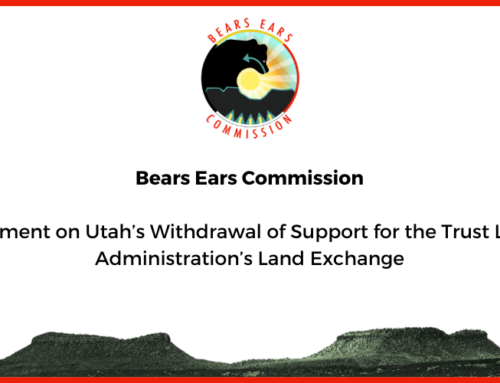The plan synthesizes Tribal perspectives for the management of the Bears Ears living landscape
Bears Ears National Monument – Aug. 26, 2022 – Today, after over two years, and thousands of hours of collaboration, the five Tribes of the Bears Ears Inter-Tribal Coalition (BEITC) have made their Land Management Plan (LMP) accessible to the public. Traditional knowledge-holders have synthesized perspectives from the five Coalition Tribes, and the plan was recently submitted to federal counterparts in the USDA Forest Service and the Bureau of Land Management.
The Coalition’s Cultural Resource Subcommittee (CRS) is composed of Tribal Historic Preservation Officers, Cultural Preservation officers, and Traditional knowledge-holders from each of the five Tribes. It is through their hard work and commitment that this plan has manifested.
Lieutenant Governor of the Pueblo of Zuni, and BEITC Co-Chair Carleton Bowekaty stated, “In the context of Bears Ears, a place we all agree, regardless of political affiliation, is stunningly beautiful with diverse terrain and a variety of complex management challenges, from intentional acts of vandalism to the exponential growth in tourism, Zuni along with the other four tribes that comprise the Bears Ears Commission are eager to share our Land Management Plan for the Bears Ears National Monument that will create a more durable landscape that can be enjoyed by everyone for centuries to come.”
This LMP represents a new way forward for Tribes to protect their off-reservation ancestral homelands and cultural resources, and demonstrates the Biden administration’s commitment to honoring and recognizing the importance of Traditional Ecological Knowledge (TEK). In addition, the Biden administration is honoring its promise to uphold the U.S.’s trust responsibility to Tribal Nations, strengthening the Nation-to-Nation relationship, and ensuring Tribes have the tools to safeguard their natural and cultural resources.
“Our culture relies on accessibility to the Bears Ears region. Through this Land Management Plan, we are strengthening our connection with our people, the environment, and all the land, water, and animals. What we are looking at is reconnecting with our Aboriginal lands and finding ways to incorporate our worldview into the management of our homelands. Having a say in how this region is managed brings us closer to our ancestors,” explained Hank Stevens (Naatsis’áán, Navajo Mountain), BEITC Representative for the Navajo Nation.
In fact, it has always been the intention and aspiration of the Coalition Leaders and members to be able to provide this plan and make it widely accessible, so that it can begin to spark conversations and change in other communities. This plan carries with it the hope to instill larger systemic change so that Tribal communities and Nations can have an authentic role and voice in the management of their ancestral homelands. The Coalition has always strived for its work to be transferable and a potential model for how Tribal Nations can advance Tribal sovereignty and strengthen self-determination. The release of this document marks a first step in making this a reality.
For too long Indigenous voices have been ignored and excluded from important and long-lasting decisions regarding their homelands. Today, with the restored Bears Ears National monument, the signing of the cooperative agreement with the Forest Service and the Bureau of Land Management, and the submission of the Coalition’s LMP, the Coalition Tribes are on track to have a meaningful say in the management of their ancestral homelands and sacred places.
See the Coalition’s Land Management Plan.
Find the Bears Ears – Land Management Plan Appendix here.



